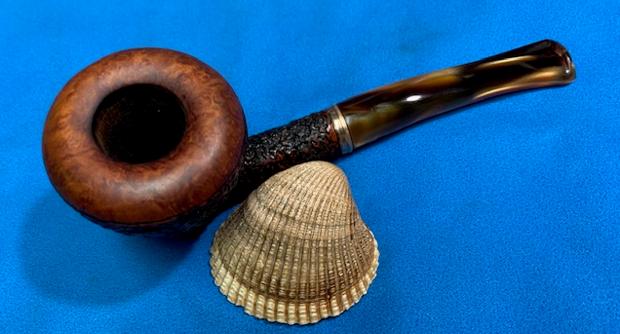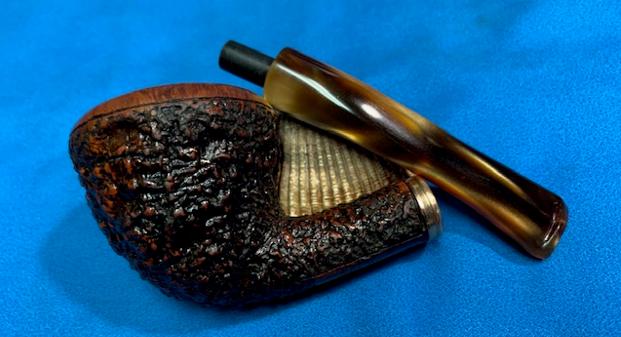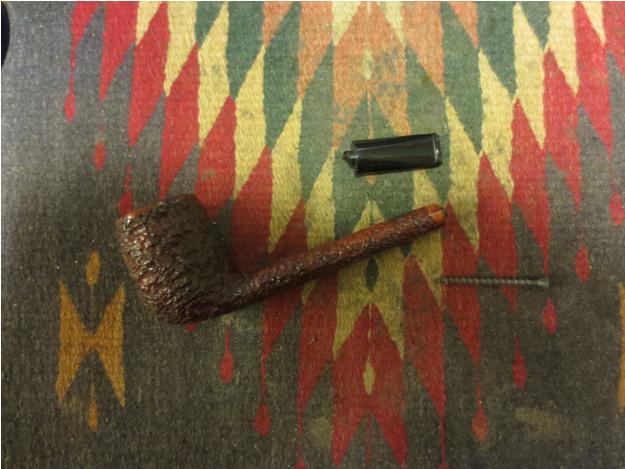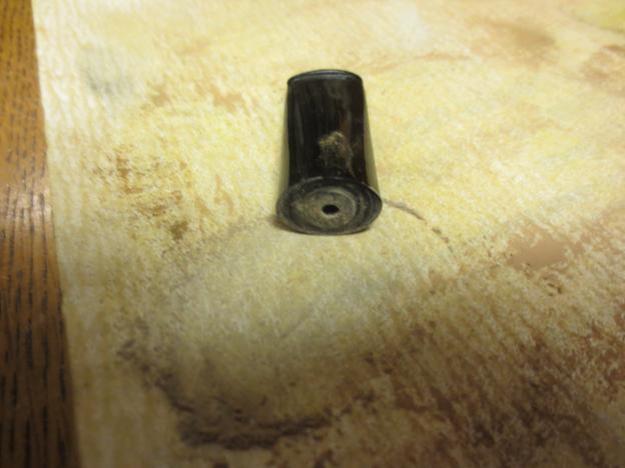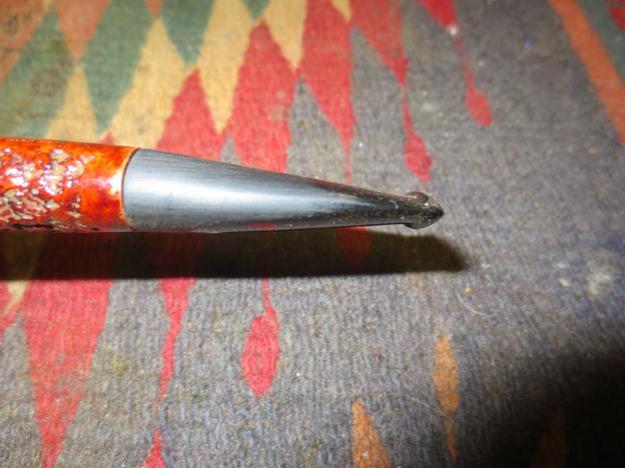Blog by Steve Laug
The next pipe I chose to work on came to us from an antique shop in Houston, Texas, USA that Jeff visited in 2018. It has been sitting in my box of bowls since that time. Jeff cleaned it up and mailed it to me. I have been postponing restemming any of the pipes for a while now but after restemming that little gourd calabash a couple of days ago I was ready to do a few more. I pulled this one out of the box first and set aside to be the next pipe to work on. It has a very craggy rustication that is quite stunning and it has a smooth rim cap and ring that make me call it a Rhodesian. It also has a smooth band on the shank end. Overall it is a pretty pipe. The bowl had been reamed before Jeff purchased it and was pretty clean. The rim top had a coat of lava that covered the majority of the cap. The finish had a lot of dust and debris in the valleys of the rustication. The stamping on the smooth panel on the underside of the shank was clear and readable. It had a J in circle [over] the shape number 303. That is followed by Gepetto [arched over] Italy [over] Hand Made. The J stamp made me immediately think of a connection to Ser Jacopo but I would look into that later in the blog.
 The next two close up photos show the condition of the bowl and rim top. You can see the thick lava coat on the top and you can see the reamed bowl sides on the left rear. It would need to be cleaned up but it was surprisingly clean for the condition of the rim top.
The next two close up photos show the condition of the bowl and rim top. You can see the thick lava coat on the top and you can see the reamed bowl sides on the left rear. It would need to be cleaned up but it was surprisingly clean for the condition of the rim top.
 Jeff took a photo of the stamping on the underside of the shank. It read as noted above and is clear and readable.
Jeff took a photo of the stamping on the underside of the shank. It read as noted above and is clear and readable. I decided to confirm my thinking that the pipe was connected with Ser Jacopo. I turned to Pipephil’s site to get a read on the brand (http://pipephil.eu/logos/en/logo-g2.html). Sure enough the Gepetto line is called a second of Ser Jacopo. I did a screen capture of the section on Pipephil on both the Gepetto line and the informative side bar from the Ser Jacopo section that also states that the line is a second. I have included them below.
I decided to confirm my thinking that the pipe was connected with Ser Jacopo. I turned to Pipephil’s site to get a read on the brand (http://pipephil.eu/logos/en/logo-g2.html). Sure enough the Gepetto line is called a second of Ser Jacopo. I did a screen capture of the section on Pipephil on both the Gepetto line and the informative side bar from the Ser Jacopo section that also states that the line is a second. I have included them below.  There were also photos that were included on Pipephil of what this particular pipe looked like when it had left Italy. The rustication around the bowl and shank is very similar though the stain on this one is darker and the grain on the smooth rim cap much more prominent. The pipe originally had an acrylic saddle stem with a silver inlaid Pinnochio on the top of the stem. The stem was long gone when Jeff picked it up so I had some decisions to make about the stem I would use to restem it.
There were also photos that were included on Pipephil of what this particular pipe looked like when it had left Italy. The rustication around the bowl and shank is very similar though the stain on this one is darker and the grain on the smooth rim cap much more prominent. The pipe originally had an acrylic saddle stem with a silver inlaid Pinnochio on the top of the stem. The stem was long gone when Jeff picked it up so I had some decisions to make about the stem I would use to restem it.
 I turned to work on the pipe itself. Jeff had carried out his usual thorough cleanup of the pipe. He had reamed it with a PipNet reamer to remove the cake and cleaned the reaming up with a Savinelli Fitsall Pipe Knife. He scrubbed the internals of the bowl and stem with alcohol, cotton swabs and pipe cleaners. He scrubbed the externals with undiluted Murphy’s Oil Soap and rinsed the bowl off with running water. The pipe looked very clean when I received it. The rim top looked better but still needed a lot of work.
I turned to work on the pipe itself. Jeff had carried out his usual thorough cleanup of the pipe. He had reamed it with a PipNet reamer to remove the cake and cleaned the reaming up with a Savinelli Fitsall Pipe Knife. He scrubbed the internals of the bowl and stem with alcohol, cotton swabs and pipe cleaners. He scrubbed the externals with undiluted Murphy’s Oil Soap and rinsed the bowl off with running water. The pipe looked very clean when I received it. The rim top looked better but still needed a lot of work.

 I went through my can of stems and found an acrylic one that had the right colour combination of browns and golds to work with the finish on the bowl. It was a little too bent but that would not be an issue. There were also tooth marks in the top and underside of the stem at the button that would need to be dealt with in the restoration.
I went through my can of stems and found an acrylic one that had the right colour combination of browns and golds to work with the finish on the bowl. It was a little too bent but that would not be an issue. There were also tooth marks in the top and underside of the stem at the button that would need to be dealt with in the restoration.
 I fit the stem in the shank and took a picture of the pipe. The stem is a little larger in diameter than the shank. I will need to sand it down to match the shank. I will also need to straighten the stem.
I fit the stem in the shank and took a picture of the pipe. The stem is a little larger in diameter than the shank. I will need to sand it down to match the shank. I will also need to straighten the stem.
 I took a close up photo of the rim top. You can see the cleanness of the bowl and rim. There is darkening around inner edge of the rim and crown top. You can also see the stem is a little larger in diameter than the shank in the photos below. You can also see the tooth marks in the second and third photos below.
I took a close up photo of the rim top. You can see the cleanness of the bowl and rim. There is darkening around inner edge of the rim and crown top. You can also see the stem is a little larger in diameter than the shank in the photos below. You can also see the tooth marks in the second and third photos below.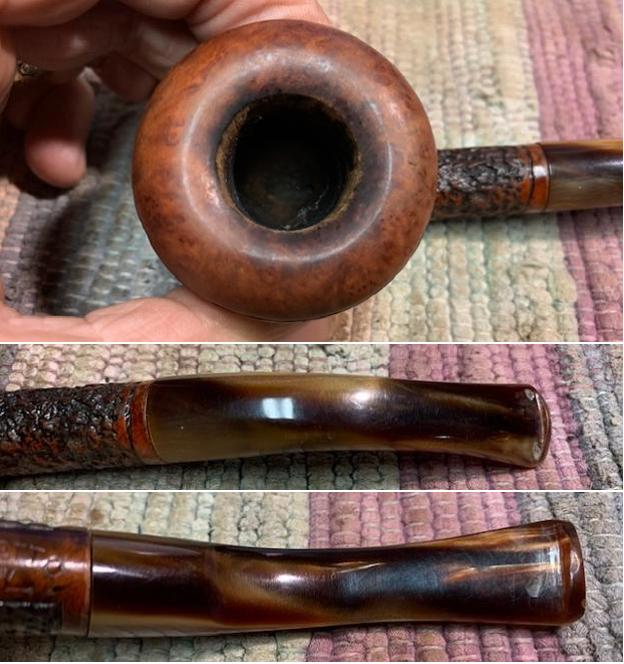 I straightened the stem over my heat gun. I put a pipe cleaner in the shank and heated it until the stem was flexible and I was able to straighten it to match the bend in the stem. I took photos of the pipe and stem after the straightening.
I straightened the stem over my heat gun. I put a pipe cleaner in the shank and heated it until the stem was flexible and I was able to straighten it to match the bend in the stem. I took photos of the pipe and stem after the straightening. I set the stem aside and worked on the rim edges and top with a folded piece of 220 grit sandpaper. I was able to remove the damage to the rim edges and top.
I set the stem aside and worked on the rim edges and top with a folded piece of 220 grit sandpaper. I was able to remove the damage to the rim edges and top. I polished the rim top with micromesh sanding pads and wiped it down with a damp cloth to remove the sanding dust. The crown took on a rich shine.
I polished the rim top with micromesh sanding pads and wiped it down with a damp cloth to remove the sanding dust. The crown took on a rich shine.
 I stained the rim top with a Maple and Cherry stain pen to match the finish on the smooth portions on the bowl.
I stained the rim top with a Maple and Cherry stain pen to match the finish on the smooth portions on the bowl. With the repair completed I rubbed the briar down with Before & After Restoration Balm. I worked it into the briar with my fingertips and a horsehair shoe brush. The product works to clean, enliven and preserve the briar. I let it sit for 15 minutes while I worked on the stem. After the time passed I buffed it with a cotton cloth to deepen the shine. The briar really comes alive with the balm.
With the repair completed I rubbed the briar down with Before & After Restoration Balm. I worked it into the briar with my fingertips and a horsehair shoe brush. The product works to clean, enliven and preserve the briar. I let it sit for 15 minutes while I worked on the stem. After the time passed I buffed it with a cotton cloth to deepen the shine. The briar really comes alive with the balm. 

 In the process of rubbing the bowl down with Before & After Balm I noticed a hairline crack in the underside of shank that needed to be addressed. I don’t know if it was present or if it cracked when I fitted the new stem. Either way it needed to be repaired. I sanded the smooth area on the shank end down with 220 grit sandpaper in preparation for the band I wanted to put on it. I found a nice brass band that was grooved to look like a double band. I heated the band and pressed it in place. The band looked very good on the shank.
In the process of rubbing the bowl down with Before & After Balm I noticed a hairline crack in the underside of shank that needed to be addressed. I don’t know if it was present or if it cracked when I fitted the new stem. Either way it needed to be repaired. I sanded the smooth area on the shank end down with 220 grit sandpaper in preparation for the band I wanted to put on it. I found a nice brass band that was grooved to look like a double band. I heated the band and pressed it in place. The band looked very good on the shank.
 I filled in the tooth marks on the stem with clear super glue and set it aside to cure. Once it had cured I sanded it down with 220 grit sandpaper. I also sanded the diameter of the stem to match the diameter of the shank.
I filled in the tooth marks on the stem with clear super glue and set it aside to cure. Once it had cured I sanded it down with 220 grit sandpaper. I also sanded the diameter of the stem to match the diameter of the shank.
 I set the bowl aside and turned my attention to the stem. I polished the acrylic stem with micromesh sanding pads – 1500-12000 grit pads. I wiped it down with Obsidian Oil after each sanding pad. I used Before & After Pipe Polish – both Fine and Extra Fine to further polish the stem.
I set the bowl aside and turned my attention to the stem. I polished the acrylic stem with micromesh sanding pads – 1500-12000 grit pads. I wiped it down with Obsidian Oil after each sanding pad. I used Before & After Pipe Polish – both Fine and Extra Fine to further polish the stem. 
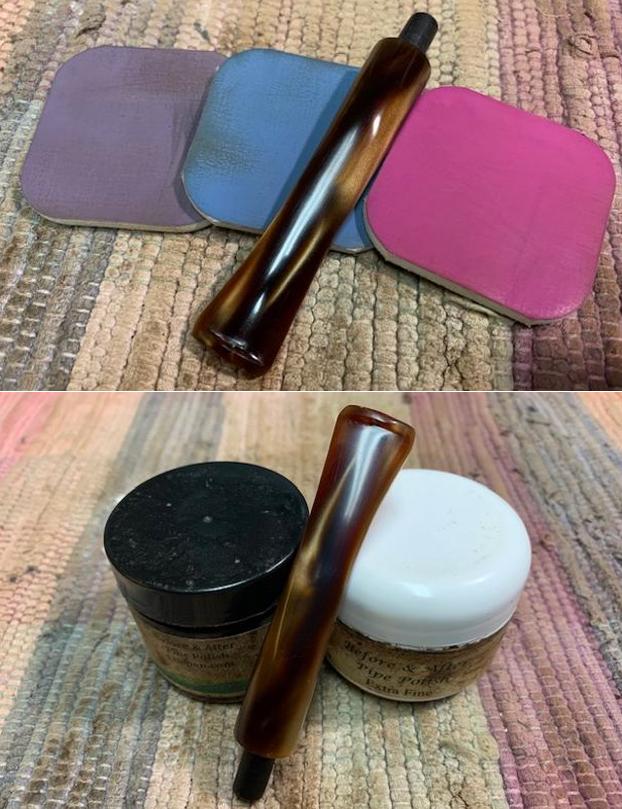 This restemmed, rusticated Gepetto 303 Rhodesian is a beautiful looking pipe that combines a smooth rim cap and rusticated bowl and shank. The brown stains on the bowl work well to highlight the grain. The polished variegated brown/gold half saddle acrylic stem adds to the mix. I put the finished stem on the bowl and buffed the pipe with Blue Diamond on the buffing wheel being careful to not buff the stamping. I gave the bowl multiple coats of Conservator’s Wax and the stem multiple coats of carnauba wax on the buffing wheel and followed that by buffing it with a clean buffing pad. I hand buffed the pipe with a microfiber cloth to deepen the shine. The rusticated pipe is quite nice and feels great in the hand. Give the finished pipe a look in the photos below. I can only tell you that like the other pipes I am working that it is much prettier in person than the photos capture. The dimensions of the pipe are Length: 6 ½ inches, Height: 2 inches, Outside diameter of the bowl: 2 inches, Chamber diameter: 7/8 of an inch. The weight of the pipe is 57grams/2.05oz. It will soon be added to the Italian Pipe Makers section on the rebornpipes store. Thanks for walking through the restoration with me as I worked over another beautiful pipe. Remember we are not pipe owners; we are pipemen and women who hold our pipes in trust until they pass on into the trust of the next generation.
This restemmed, rusticated Gepetto 303 Rhodesian is a beautiful looking pipe that combines a smooth rim cap and rusticated bowl and shank. The brown stains on the bowl work well to highlight the grain. The polished variegated brown/gold half saddle acrylic stem adds to the mix. I put the finished stem on the bowl and buffed the pipe with Blue Diamond on the buffing wheel being careful to not buff the stamping. I gave the bowl multiple coats of Conservator’s Wax and the stem multiple coats of carnauba wax on the buffing wheel and followed that by buffing it with a clean buffing pad. I hand buffed the pipe with a microfiber cloth to deepen the shine. The rusticated pipe is quite nice and feels great in the hand. Give the finished pipe a look in the photos below. I can only tell you that like the other pipes I am working that it is much prettier in person than the photos capture. The dimensions of the pipe are Length: 6 ½ inches, Height: 2 inches, Outside diameter of the bowl: 2 inches, Chamber diameter: 7/8 of an inch. The weight of the pipe is 57grams/2.05oz. It will soon be added to the Italian Pipe Makers section on the rebornpipes store. Thanks for walking through the restoration with me as I worked over another beautiful pipe. Remember we are not pipe owners; we are pipemen and women who hold our pipes in trust until they pass on into the trust of the next generation.

